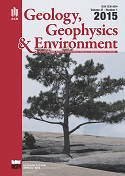The analysis of vertical displacements in Upper Silesian Coal Basin area using DInSAR and PSInSAR methods
DOI:
https://doi.org/10.7494/geol.2015.41.1.96Keywords:
satellite radar interferometry, DInSAR, PSInSAR, USCB, subsidenceAbstract
The main goal of this study is an analysis of vertical displacements in Upper Silesian Coal Basin (USCB) using two satellite radar interferometry methods: Differential Interferometry Synthetic Aperture Radar (DInSAR) and Persistent Scatterer Interferometric Synthetic Aperture Radar (PSInSAR) (Ferretti et al. 2007). To detect ground deformations using the PSInSAR method many satellite images (even tens) are needed, while using the DInSAR method, a pair of satellite images is needed. Satellite images are provided inter alia by European Space Agency and were obtained between 1990-2001 (PSInSAR) and 1996-2001 (DInSAR) by ERS-2 satellite. The USCB is located in south-western Poland and is highly industrialized and densely inhabited region, because of the presence of many active underground stone coal mines. Vertical displacements presented in work are conducted by underground mining exploitation and neotectonic movements. In the main, the DInSAR method allows to detect big (a few or several centimeters) and intensive (formed in a few days, 35-140 days) vertical displacements on a big area in the same time. The PSInSAR method in the main allows to detect small and permanent vertical displacements (Leśniak & Porzycka 2008), which are correlated with neotectonic movements. It is noteworthy that results obtained using the PSInSAR method have low coherence in the areas of vertical displacements detected by using the DInSAR method. Big and intensive vertical displacements are not detected while using the PSInSAR method. Only using both methods (DInSAR and PSInSAR) allows to generate a complex map of vertical displacements, which is essential for the realization of local zoning plans in the USCB area. Obtained in this work map of vertical displacements is collated with: (1) seismic data from Główny Instytut Geologiczny (GIG), (2) locations of mines in the USCB, (3) borders of coal deposits, (4) tectonics map (Jureczka & Kotas 1995), (5) mining extraction data from Kompania Węglowa S.A.Downloads
References
Ferretti A., Monti-Guarnieri A., Prati C., Rocca F., „InSAR Principles: Guidelines for SAR Interferometry Pro-cessing and Interpretation”, ESA Publications ESTEC, Noordwijk, The Netherlands, 2007 [@] http://www.esa.int/About_Us/ESA_Publications/InSAR_Principles_Guidelines_for_SAR_Interferometry_Processing_and_Interpretation_br_ESA_TM-19
Jureczka J., Kotas A., 1995: Upper Silesian Coal Basin. W: "The Carboniferous system in Poland". Pr. Pol. Inst. Ge-ol., 148, 164-173.
Leśniak A., Porzycka S.: Environment monitoring using satellite radar interferometry technique (PSInSAR). Polish Journal of Environmental Studies, vol. 17 no. 3A, 382--387b (2008).
MIDAS database [@] http://geoportal.pgi.gov.pl/portal/page/portal/MIDASGIS/start
Rocca F., DINSAR: Differential SAR Interferometry [@] http://earth.esa.int/landtraining07/D1LB5-1-Rocca.pdf
Downloads
Published
Issue
Section
License
Authors have full copyright and property rights to their work. Their copyrights to store the work, duplicate it in printing (as well as in the form of a digital CD recording), to make it available in the digital form, on the Internet and putting into circulation multiplied copies of the work worldwide are unlimited.
The content of the journal is freely available according to the Creative Commons License Attribution 4.0 International (CC BY 4.0)










